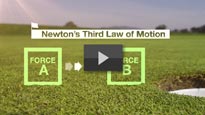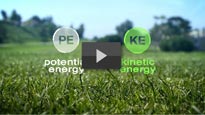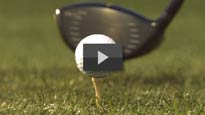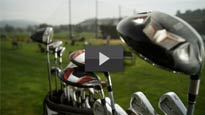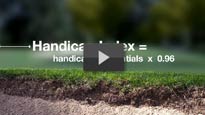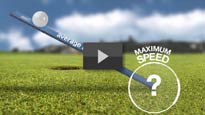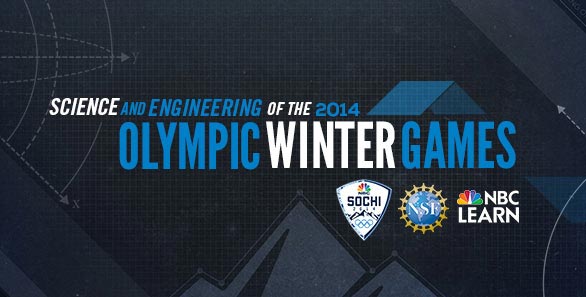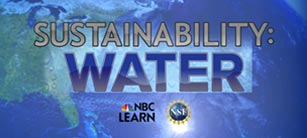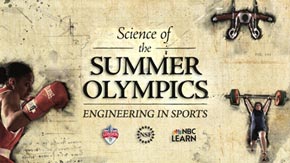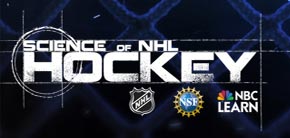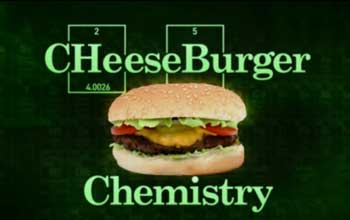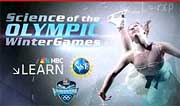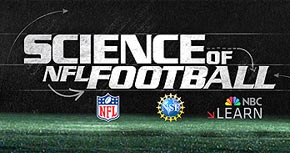

Special Video Report:
Science of Golf
Courtesy: NBC Learn, the United States Golf Association and Chevron
This new 10-part series continues to explore the physics and math behind the game of golf. Provided by NBC Learn, in partnership with the United States Golf Association and Chevron, students will learn about calculating golfers’ handicaps and golf scoring, the evolution of the golf club and ball, as well as how factors like friction, volume and energy all affect how a golf ball travels.
Select a video by clicking on a topic below
Science of Golf: Course Setup
Golf tournaments aim to be a complete test of a golfer’s ability, which includes having a firm golf course, which is tested using a device called the TruFirm. Another factor is speed on putting greens, measured by a Stimpmeter device. The entire process of determining course set-up involves a combination of science, engineering, math and technology to provide the ideal hole locations.
Science of Golf: Meteorology & Weather
Wind, rain, air pressure and temperature all affect a golfer’s shot and cause many delays in a game or match. Meteorologists use scientific models and data to determine what weather events are likely to occur and stop play if lightening becomes a concern. Knowing weather conditions can also help golfers use the wind or wet greens and fairways to their advantage.
Science of Golf: How the USGA Determines the Pace of Play
Pace of play, which means how long it takes to make your way through a nine- or eighteen-hole course, can lead to frustration if players are left waiting too long. The science behind improving pace of play involves flow rate of players throughout the round, as well as time intervals between groups, known as cycle times.
Science of Golf: Newton’s Third Law of Motion & Momentum
Power and speed are concepts that most people would connect with golf. However, there is more to these broad ideas, and that’s where Newton’s third law of motion comes into play. When the ball and club interact, they apply equal and opposite forces on each other, causing the impulse, which speeds up the ball and slows the club.
Science of Golf: Energy in Collisions & Compressions
Collisions, when two objects come into contact, and compressions, the resulting impact, are key concepts to the ideal golf swing. The resulting effect is the golf ball deforms and springs back, storing some of the kinetic energy as potential and then using that energy to fly off the club.
Science of Golf: Golf Course Agronomy
Agronomy is the practice used to create an ideal golf environment and enable the turfgrass to grow in the conditions it is best suited for. Aspects such as amount of water, fertilizer and pest control products all factor into the environment for each grass across the country.
Science of Golf: Why Golf Balls Have Dimples
It is a well-recognized fact of the sport: golf balls have dimples. The lesser-known information is the reason they are produced that way, which is related to aerodynamic drag, also known as wind resistance. The change in airflow because of the impressions in the ball creates air disturbance and allows the ball to fly farther.
Science of Golf: Newton’s First & Second Laws of Motion
Newton’s first law of motion, the Law of Inertia, and second, which explains the idea of acceleration, are crucial to all aspects of the golf game. From the moment of impact between the club and ball, the flight of the ball, to the bounce and roll of a golf ball when it lands, both laws are at play to explain how the force applied to the ball produces its’ flight path.
Science of Golf: Potential & Kinetic Energy
Every golf swing relies on potential and kinetic energy in order to move the ball. Potential energy is the energy an object has because of its position or capability to move. Potential energy can come from chemical energy in a golfer’s muscles that allow them to swing a golf club. Kinetic energy is the energy of an object in motion, encompassing the motion, heat, and sound released when a golf ball is hit.
Science of Golf: Torque & Moment of Inertia
The mechanics behind a golf swing are crucial to a golfer’s ability to hit the ball straight and with the proper amount of power. Torque and moment of inertia are they key physics concepts behind this goal. The golfer’s body applies torque to their own body, the club, and finally the club head, which results in how the ball is hit.
Science of Golf: Evolution of the Golf Ball
This segment discusses the transformation of the golf ball from the original wood to leather stuffed with goose feathers, tree sap, and finally today’s synthetic materials. Do you know why golf balls aren’t smooth, but instead have a dimpled surface? Find out in this video how that chance discovery was made, as well as the science behind it. See what is inside of a golf ball, why each material is used, and the guidelines for golf balls in the PGA.
Science of Golf: Evolution of the Golf Club
Similar to the “Evolution of the Golf Ball” segment, this video explores the design and engineering of golf clubs evolved from handcrafted hardwoods to what golfers use today. Learn about scientific principles such as mass distribution, inertia and acceleration, in the context of carefully creating golf clubs to ensure the best possible force behind the ball. Also, see how golf clubs are tested in laboratory settings to determine their effectiveness, comparing the old-fashioned wood clubs to today’s titanium.
Science of Golf: Volume, Displacement & Buoyancy
There are strict limits on the volume of golf clubs, but how could that affect golfer’s performance in the game? Find out in this segment why volume of club heads is important, as well as how to find volume using water displacement instead of measurements. Using the video, combine these concepts with inertia to understand how they come together to affect the power behind the golf ball.
Science of Golf: Calculating a Golf Handicap Index
If you've ever heard the term “handicap” in golf, you know it’s an advantage that players get to even the field. What you may not know is how handicaps are determined. In this segment, explore the reason for the handicaps as well as the mathematics behind determining a player's handicap. Also learn how the averages come into play and how the USGA uses handicaps to encourage players to improve their game.
Science of Golf: Math of Golf Scoring
Golf is filled with numbers, statistics and math, but how much do you know about the different numbers of golf scoring? In a previous video, we learned about handicapping, but how does that factor into the overall score of a game? Learn about pars, positive versus negative numbers in golf, and aggregated scores in tournaments.
Science of Golf: Physics of the Golf Swing
This video breaks down the powerful golf tee shot into three major physics concepts: torque, centripetal force, and the double pendulum effect. Learn how the way a golfer’s centripetal force created by their body can affect a golf shot, and what parts of the golfer’s body create the double pendulum. Also explore how the torque of a shot influences the rotation of the ball to create a powerful shot.
Science of Golf: Friction & Spin
This segment focuses on golf’s short game, using shorter clubs to get the ball close to the hole. Explore how different uses of spin can affect where the ball lands, such as backspin for the ball to stop quickly after landing, as well as how the spin is created by the club. Have you ever noticed the groves on the face on a golf club? Learn why those are included in order to improve the force of friction, which determines the spin of the ball.
Science of Golf: Kinematics
We've all seen professional golfers "reading the green" when preparing for a putt, but what are they looking for? In this video, learn the science behind the green, including how the friction and slope of the green affects the speed of the ball. Explore how this all comes together in the scientific term “kinematics,” which refers to acceleration, position and velocity to describe motion. This video also explains how professionals measure green speed, as well as the science behind the speed.
Science of Golf: Work, Energy & Power
An excellent demonstration of the physics concepts of work, energy and power, this video explores the science of putting in golf. Learn about the different types of energy and how it is transferred from the club to the ball, how the amount is work is determined using force and distance, and how much power is used, which is known as how much work is completed over a period of time, all in the context of a putt.
Science of Golf: Water Conservation
Conserving water resources has become an important concern in recent years. This segment discusses how turf and water conservation specialists educate golf courses superintendents on conserving water at their course. Techniques like capturing rainfall, using recycled water and developing new varieties of turf grass are used to maximize the efficiency of the water that courses use. The video also describes new high-tech tools that courses use to find soil moisture, and some of the factors that affect moisture, such as evapotranspiration.
Distributed by NIEonline.com with permission
More NIE
Special Reports
►2014 Winter Olympics
►Fighting With Food
►Sustainability: Water
►Science of Innovation
►Writers Speak to Kids
►Summer Olympics
►Science behind the News
►Science of Hockey
►Black History Month
►Changing Planet
►Cheeseburger Chemistry
►Chemistry Now
►Science of the Olympics
►Science of Football
►CyberBullying
About NBC Learn
NBC Learn is the educational arm of NBC News dedicated to providing resources for students, teachers, and lifelong learners. The online resources NBC Learn has created for the education community leverages nearly 80 years of historic news coverage, documentary materials, and current news broadcasts. Currently two offerings, NBC Learn K12 and NBC Learn Higher Ed, give students and teachers access to thousands of video clips from the NBC News archives, including great historic moments--from the Great Depression to the Space Race to the latest political coverage. NBC Learn also offers primary source materials, lesson plans and classroom planning resources, and additional text and image resources from our content partners. For more information, visit www.nbclearn.com.
Additional Resources
NBC Learn K12
Additional resources
Lessons & Classroom Activities
- Cartoons for the Classroom
- Front Page Talking Points
- This Week in History
- News Video
- Science Webcasts
- Headline Geography
Resources by grade level




